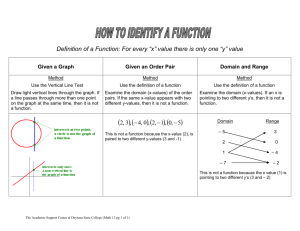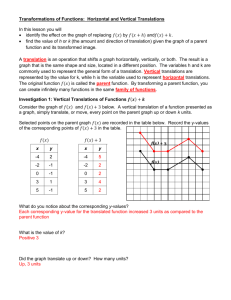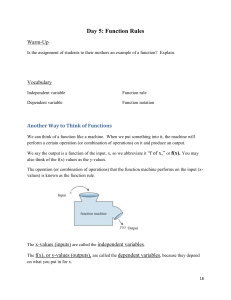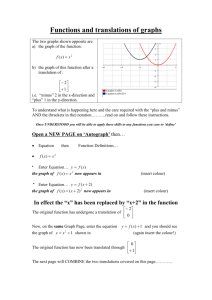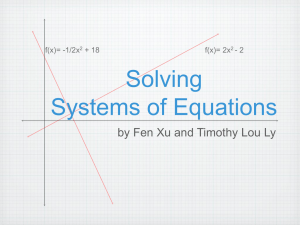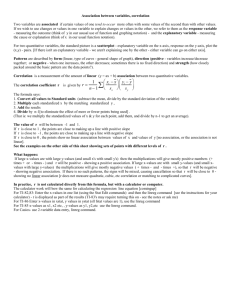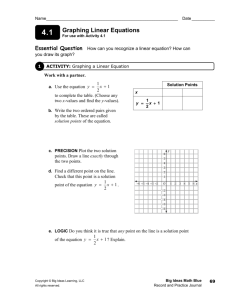Transformations of Functions
advertisement
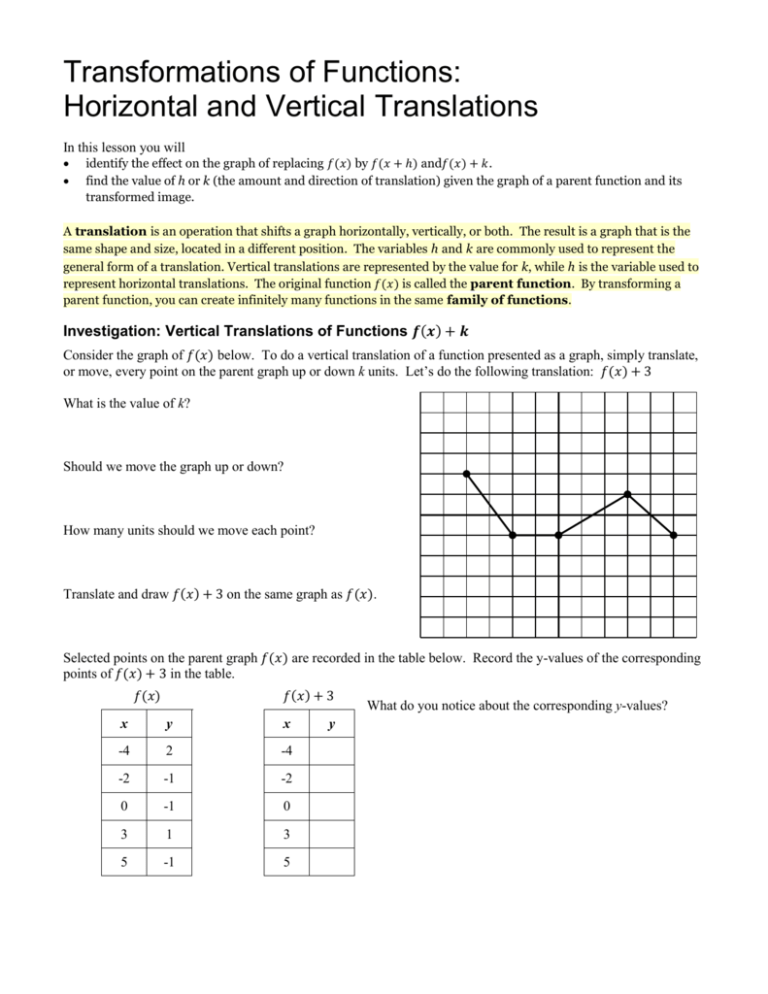
Transformations of Functions: Horizontal and Vertical Translations In this lesson you will identify the effect on the graph of replacing 𝑓(𝑥) by 𝑓(𝑥 + ℎ) and𝑓(𝑥) + 𝑘. find the value of h or k (the amount and direction of translation) given the graph of a parent function and its transformed image. A translation is an operation that shifts a graph horizontally, vertically, or both. The result is a graph that is the same shape and size, located in a different position. The variables h and k are commonly used to represent the general form of a translation. Vertical translations are represented by the value for k, while h is the variable used to represent horizontal translations. The original function 𝑓(𝑥) is called the parent function. By transforming a parent function, you can create infinitely many functions in the same family of functions. Investigation: Vertical Translations of Functions 𝒇(𝒙) + 𝒌 Consider the graph of 𝑓(𝑥) below. To do a vertical translation of a function presented as a graph, simply translate, or move, every point on the parent graph up or down k units. Let’s do the following translation: 𝑓(𝑥) + 3 What is the value of k? Should we move the graph up or down? How many units should we move each point? Translate and draw 𝑓(𝑥) + 3 on the same graph as 𝑓(𝑥). Selected points on the parent graph 𝑓(𝑥) are recorded in the table below. Record the y-values of the corresponding points of 𝑓(𝑥) + 3 in the table. 𝑓(𝑥) 𝑓(𝑥) + 3 x y x -4 2 -4 -2 -1 -2 0 -1 0 3 1 3 5 -1 5 y What do you notice about the corresponding y-values? Use what you have just discovered to fill in the y-values for 𝑔(𝑥) − 4. Then graph both 𝑔(𝑥) and 𝑔(𝑥) − 4 on the same set of axes using different colors. Label each function. 𝑔(𝑥) 𝑔(𝑥) − 4 x y x -5 2 -5 -3 3 -3 0 2 0 1 1 1 2 -2 2 y What is the value of k? How does the second graph compare to the parent function? Based on what you have seen, fill in the following: When the value of k is ____________________, the parent graph is translated k units up. When the value of k is ____________________, the parent graph is translated k units down. Investigation: Horizontal Translations of Functions 𝒇(𝒙 + 𝒉) Consider the parent function 𝑓(𝑥) = 2𝑥 + 3. Let’s do the following translation: 𝑓(𝑥 + 2) To do this algebraically, we would replace “x” in the parent function 𝑓(𝑥) with “𝑥 + 2”: 𝑓(𝒙) = 2𝒙 + 3 → 𝑓(𝒙 + 𝟐) = 2(𝒙 + 𝟐) + 3 So our new function is: 𝑓(𝑥 + 2) = 2(𝑥 + 2) + 3 This function can be simplified by using the distributive property and combining like terms: 𝑓(𝑥 + 2) = 2𝑥 + 4 + 3 𝑓(𝑥 + 2) = 2𝑥 + 7 Let’s see what this looks like in table and graph forms. First, find the corresponding y-values for the selected x-values in the first table below. Then find the corresponding x-values for the selected y-values in the second table by using the equation and working backwards. Then graph each function in a different color on the same set of axes. Be sure to label each function. 𝑓(𝑥) = 2𝑥 + 3 x 𝑓(𝑥 + 2) = 2𝑥 + 7 y x y -3 -3 -2 -1 0 3 1 5 Was the parent function translated to the left or to the right? What is the value of h? How are the x-values in the two tables related? How are the y-values in the two tables related? Now consider the parent function 𝑔(𝑥) = |𝑥|. This is the absolute value function. For each value of x, the corresponding y-value is the distance of the x-value from zero on the number line. For example, 𝑔(−4) = |−4| = 4, since −4 is 4 units from zero on the number line. Fill in the values for 𝑔(𝑥) in the table on the next page and graph the points. Then finish graphing 𝑔(𝑥) by connecting the points to form a “V” shape. Next, let’s graph a translation of the absolute value function: 𝑔(𝑥 − 3) Algebraically speaking, 𝑔(𝑥 − 3) = |𝑥 − 3|. For the second table, find the corresponding y-values for the selected x-values. Then graph the translated function in a different color on the same set of axes. Be sure to label each function. 𝑔(𝑥) = |𝑥| 𝑔(𝑥 − 3) = |𝑥 − 3| x y x -3 3 0 -2 -1 1 1 2 0 3 1 4 2 2 5 3 6 4 7 5 y 5 8 Was the parent function translated to the left or to the right? What is the value of h? How are the x-values in the two tables related? How are the y-values in the two tables related? Based on what you have seen, fill in the following: When the value of h is ____________________, the parent graph is translated h units left. When the value of h is ____________________, the parent graph is translated h units right. Combinations of Vertical and Horizontal Translations of Functions EXAMPLE Examine the equation for each parent graph, table, or equation (labeled 𝑓(𝑥)) and its corresponding transformed graph, table, or equation (labeled 𝑡(𝑥)). Describe the translation. a) 𝑡(𝑥) 𝑓(𝑥) b) 𝑓(𝑥) x y -2 4 -1 1 0 0 1 1 2 4 3 9 𝑡(𝑥) x y -2 10 -1 7 0 6 1 7 2 10 3 15 c) 𝑡(𝑥) = 𝑓(𝑥) − 7 d) 𝑓(𝑥) 𝑡(𝑥) e) 𝑡(𝑥) = 𝑓(𝑥 + 5) f) 𝑡(𝑥) = 𝑓(𝑥 − 8) + 3
